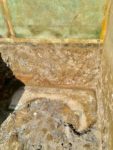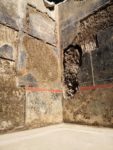 The name of a young girl scratched on the frescoed wall of a luxury villa in Pompeii has proven to be an invaluable clue to the home’s owner. A graffito of the name “Mummia” was found 4.5 feet above the floor on one of the interior walls of the villa. The low height of the name indicates the graffiti artist was a child, probably Mummia herself and likely a member of the family to be so bold as to write on the finely painted walls.
The name of a young girl scratched on the frescoed wall of a luxury villa in Pompeii has proven to be an invaluable clue to the home’s owner. A graffito of the name “Mummia” was found 4.5 feet above the floor on one of the interior walls of the villa. The low height of the name indicates the graffiti artist was a child, probably Mummia herself and likely a member of the family to be so bold as to write on the finely painted walls.
Mummia is the female version of the gens (family name) Mummius. By Roman naming conventions, the praenomen (personal name) of girls was usually the female version of the family name, so it’s likely the girl who scribbled on the wall was Mummia Mummius. The plebian Mummius family came to prominence in the 2nd century B.C. when Lucius Mummius was the first of the family to be elected consul in 146 B.C. As consul, he led the Roman army in the Achaean War against Greece and conquered Corinth with scorching brutality. He was granted a triumph upon his return to Rome and received the agnomen Achaicus in recognition of his conquest. He was the first New Man (someone with no consuls in his ancestry) to be so honored.
 Among the women of the gens, only one Mummia has a notable presence in the history books. Mummia Achaica, great-grandaughter of the general, was the mother of the emperor Servius Galba who took the throne after the suicide of Nero. His brief reign from June 68 A.D. to January 60 A.D. ushered in the Year of the Four Emperors.
Among the women of the gens, only one Mummia has a notable presence in the history books. Mummia Achaica, great-grandaughter of the general, was the mother of the emperor Servius Galba who took the throne after the suicide of Nero. His brief reign from June 68 A.D. to January 60 A.D. ushered in the Year of the Four Emperors.
The villa north of the city walls was first discovered in 2018 and made the news for the discovery of three sets of horse remains, including the first confirmed horse ever discovered in Pompeii. Archaeologists began the excavation as an emergency salvage operation after looting tunnels under the house imperiled its structural stability. They first unearthed the service rooms of the grand suburban villa, including stables and servants’ quarters.  Continuing excavations this year have brought to life the family’s living space. The team has unearthed beautifully frescoed vault of a large cryptoporticus which has yet to be fully explored. Mummia’s handiwork was discovered on one of the walls of the cryptoporticus.
Continuing excavations this year have brought to life the family’s living space. The team has unearthed beautifully frescoed vault of a large cryptoporticus which has yet to be fully explored. Mummia’s handiwork was discovered on one of the walls of the cryptoporticus.
When the stable was discovered in 2018, archaeologists deduced from the thoroughbred horse, bronze plated saddle and tack that the villa must have belonged to a military officer of high rank. Thanks to that scamp Mummia, we now have solid evidence that officer was a  member of the Mummius family. They held a number of important political and military officers in the 1st century before Pompeii was destroyed. One of them, Mummius Lupercus, fought the rebellious Germanic Batavi in 69 A.D., just 10 years before the eruption of Vesuvius. (He was defeated, captured and killed, so if the villa had been his, it wasn’t anymore by the time that horse was saddled to take his master out harm’s way. The horse didn’t make it, so his master probably didn’t either.)
member of the Mummius family. They held a number of important political and military officers in the 1st century before Pompeii was destroyed. One of them, Mummius Lupercus, fought the rebellious Germanic Batavi in 69 A.D., just 10 years before the eruption of Vesuvius. (He was defeated, captured and killed, so if the villa had been his, it wasn’t anymore by the time that horse was saddled to take his master out harm’s way. The horse didn’t make it, so his master probably didn’t either.)
Serbia’s Galba. Was Emperor from June 68 to January 69.
Her name would be just Mummia, unless she had a second name (Cognomen or agnomen) like Mummia Achiaca. Mummia is her nomen, as only men had a praenomen. Mummius is a masculine form and would not be part of a woman’s name – being called Mummia would be enough to mark her as from that family.
Roman women’s names are this fascinating combination of really marking them out as part of their birth family (they didn’t change them at marriage) while at the same time denying individuality, since in the traditional way of naming all sisters had the same name! This can cause historians problems trying to figure out, for example, precisely which Clodia or Terentia or Julia someone is talking about!